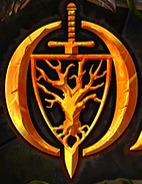There are several reasons that a game may need or benefit from an upgraded storage solution. Some games are produced with substandard component storage in the box. This includes the biggest sin of all - no organiser at all. Some organisers don't allow space for the use of using card sleeves to protect components. Whilst others get expanded and to reduce clutter merging into one box is a good strategy, but most boxes are not designed to do this.
Oathsworn doesn't really meet any of these criteria. The game comes with a number of lidded vac trays, cardboard card caddies and ziplock plastic baggies. These all do a fairly good job of storing and protecting the game components (of which there are many). However a game such as Oathsworn is generally an investment you will want to treasure for many years (unless you're the type to smash out a couple of playthroughs and move on). Therefore, to store your maps, game board, player mats (12), dice (45), tokens (300+) standard cards (1240+) and much more, you want something that will last.
While the original organisers are pretty good, at the end of the day they are made of card and standard thickness vacuum formed plastic. This is where Laserox can help. Laserox organisers are made from laser cut and engraved 3mm birch plywood and are significantly sturdier.
When asked to construct and review the Oathsworn organiser by Laserox, I was excited to see how the experience would differ from the Hogwarts Battle organiser I had previously reviewed. I immediately considered what finishes I could apply to the wood to create a thematically appropriate appearance. However, I was a little disappointed to find that this wouldn't work/be necessary for this product. While the Hogwarts Battle organiser had some shaped dividers and a couple of laser-etched details, the Oathsworn organiser has many more small cut and engraved details that would be obscured by most finishes that would be appropriate, or even by an overly heavy hand when sanding. However, I soon warmed up to these small details. Some were only decorative, such as etched designs/patterns whereas some were functional such as engraved labels as to the type of cards in a caddy.
My other early impression was that this was a significantly larger project than the Hogwarts Battle organiser. The Oathsworn organiser comes flat packed as 13 sheets of plywood slightly larger than A4 (by comparison Hogwarts Battle organiser was only three) and one plastic component. Realising this, I became quite glad that Laserox had 'pre-decorated' the organiser, as individually finishing each component before assembly as I had done previously would be a very long endeavour.
With 154 components creating 22 items (not including lids and removable dividers) it is not a good idea to simply remove them all from the plywood sheets in one go and hope for the best. Luckily, Laserox provide a pretty good set of diagrams detailing where to find each piece and how to assemble each item. Some items are duplicates or near duplicates of each other, but even if you group them together the most you will be working on at one time is about four.
Knowing that just locating components for each item, removing them from the sheets, clean up and assembly 22 times over would be several hours of effort I jumped straight in.
Following the instructions and the component map, I carefully removed each piece with a fine blade. I personally used a disposable scalpel, but an X-ACTO knife or Stanley blade will also work. I examined all the components as I removed them from the sheets. I found that like the previous organiser I’d built they would need a bit of clean-up to get a good finish.
This is not due to any defects but is just the nature of the materials used. No matter how carefully you cut out pieces, some small traces of the tags remain leaving either a small bump or a course edge. Some of these can result in small splits and splinters if not tackled properly. But don’t worry, this is easily managed.
To tackle the tag remnants and any potential splits and splinters, the solution is fine grade sandpaper or an emery board. However, do be gentle; many of these tags occur on connecting and gluing tabs which are themselves quite fine and an overly heavy hand could take away or break necessary material and reduce their effectiveness. If you have a steady hand, however, you should be able to do this freehand. If not, I recommend using either a flat surface to place the sandpaper on, making it easier to keep steady and square, or attach the sandpaper to a surface that will hold it at 90 degrees when sat on a table and then rest components on the table when sanding against this surface. For this project, I made a 90-degree sanding board to assist, but with this many pieces I had to keep moving up the sandpaper by stacking and replacing the paper regularly.
Each time I completed cleaning up a set of components, I then assembled the item(s). My preferred wood glue is Titebond, which takes hours to dry all the while needing to be taped or clamped in place. However, for this organiser project I came armed with Laserox's 5-minute glue which is basically a fast-setting PVA wood glue. Normally, I'm not a fan of fast setting adhesives as they're often not as strong as slow setting ones. However, given the size of the project I was glad to have this faster method to hand. Although sometimes when doing large, fiddly or tight fitting parts, then 5 minutes can be a little too quick and you end up fighting against the clock to assemble before the working time runs out. The precision laser-cut joints tend to be quite tight fitting, which does not allow for a dry run when assembling, but as long as you have followed the guide and have the right parts they will go together. The glue can, albeit briefly, act as a lubricant and for most joints finger pressure and gentle wiggling will be sufficient. In rare situations where a joint is particularly tight or the glue is starting to dry light, careful but firm taps from a pin or hobby hammer should work.
With the fast-setting glue, the joints held themselves for the most part while drying fully. Where they did not, I simply held them by hand or used masking tape. I was quite happy with the performance of the Laserox adhesive and found that application with a toothpick or similar item was the best method. Being careful to use correct amount of glue I found that the small 15ml bottle to be just enough to complete this project.
Once all of the token trays, card caddies, boxes etc. are assembled, they are ready to use. However, it is possible to elevate the finish quality of these organisers with a little extra work, which in my opinion makes all the difference. I sanded down all the edges and faces that I reasonably could without marring the engraved details. This really improves how they feel when handled, especially if you slightly round off the edges. From here, you can simply remove all the sanding dust and start using the organiser, but when you are looking to make something that will last it is a good idea to protect it. Thus, I recommend taking the time to seal the surface with a good quality wood finish. Ideally given the small scale and laser etched details you need something clear that won't raise the grain too much. Then apply in thin coats. On this product, I applied three thin coats of water-based varnish, which gave good protection but was not as silky smooth a finish as I desired. To accomplish this, I then applied a single coat of clear furniture wax on the exterior faces to achieve a lovely finish. Alternative finishes you could use would be oils or polywax finishes.
Additionally, if you have the time/patience and feel artistic or adventurous you could choose to 'colour in' some of the laser engraved details. For this example, I applied the first coat of varnish to seal the surface. Then, using a very fine paint brush and a steady hand, I applied some water based acrylic craft paint. I was very pleased with the results and finished the piece with two more coats of varnish to seal the wood and paint.
So at the end of this journey, it all comes down to how well the organiser fulfils its purpose. Regardless of ease of construction, durability or aesthetics, it is of course functionality that is most important...
Swapping over from the manufacturer's standard organiser was fairly straight forward but did take a little time, and the occasional bit of head scratching. This was simply because of the sheer number of game and organiser components to work with. Additionally, the storage placement and organisation were slightly different to the original. However, this was not a significant challenge and may have been hampered slightly by being new to the Oathsworn game at the time.
Once all the various trays, boxes and caddies were full, it was time to repack this beast back into its box. Laserox thankfully included a diagram with the build instructions on how to do this. Alternatively, there is also a short video on the Laserox website on how to pack this away as well.
Whilst stacking items in the box, I was impressed by the level of protection the components now had. Items such as the dice and deepwood tiles were far better protected. The way everything fitted together so neatly was very satisfying; it was like playing a 3D Tetris. Initially, I was concerned that many of the tokens went from lidded storage to open tray storage. However, it became clear that many such trays were sealed by items on top of them. Also, given the sheer size and weight of the filled box makes it unlikely to be stored on its side. The only detractor from the organisers quality and fitting is the 2cm box lid rise. But this is very minor as this will be stored flat and not have anything on top. I think the only reason that this is noteworthy is because of how beautifully everything packs away, you just wish you had that last cherry on top satisfaction of a full lid close.

I enjoyed this build, but it did take a long time to put together and is hard work to do more than a basic pop out and glue up. However, like any such project it is definitely worth putting in the extra effort to elevate the final outcome. I particularly liked some of the laser engraving and the cleaver box fastening solution.
this is a good solid product which does its job. It organises and is definitely sturdier than the original, providing greater protection. However, I would hesitate to call this a necessary accessory. The standard manufacturers organiser is certainly fit for purpose, and while it's not as neat or hard wearing it is lighter and has no lid rise.
while this organiser from Laserox is a far cry from a useless item it is an expensive upgrade (currently 83 Euros, roughly £70) that overall gives you little that you don't already possess, and it is this more than anything else that prevents it from being truly legendary. Therefore, my DOALG dice score for this product is, by a hair's width, a 5/6.
Sam-Wise
For more information on Laserox organisers including buying and shipping check out our first article featuring their products here (www.doalg.co.uk/post/laserox-hogwarts-battle-organiser).








































































Comments